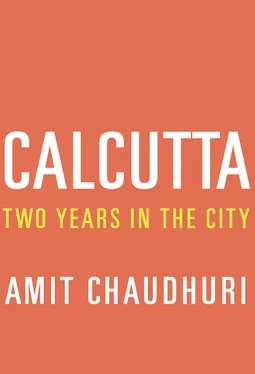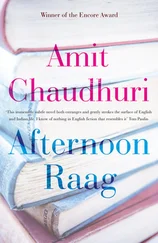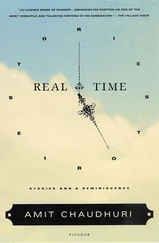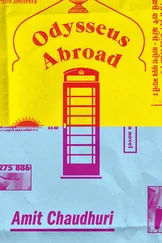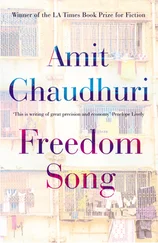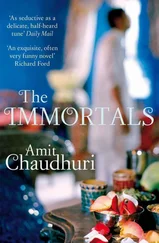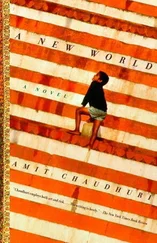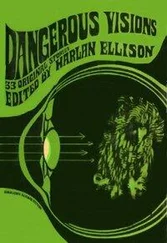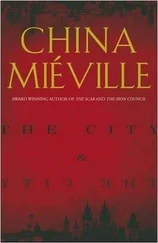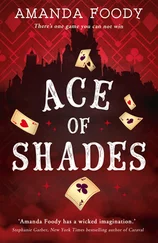Nevertheless, the news, probably from Nagen, that the illness had relapsed — without too many visible symptoms, as far as I could see — was cause for concern. TB had disappeared from Calcutta and the world, and then it resurfaced here in the eighties, initially as treatable as any minor infection, and then emerging in fatal variants. Was it “too late” for Shampa? It hardly seemed so. Yet, bantering lightly with her, I was nervous — mainly for my daughter. Shampa spent no more than one or two or three afternoons with us on that visit, but that felt like one afternoon too many. When I looked upon her, I felt the odd disquiet I’d felt, in 1986, watching my music teacher singing raga Abhogi on the stage, and noticing something about his colour that made me uncomfortable. I’d had a premonition, then — not of death, but of death that could be averted. I had the same hunch when I viewed Shampa. We decided to send her to Dr. Nandy, our new physician, with an array of medical reports and X-rays. Dr. Nandy wasn’t too happy: “She hasn’t been cured,” he said, “and it’s coming back. The treatment hasn’t been right.”
Looking for a phone number in a notebook kept in my bedside drawer, I find Shampa’s name and contact details in my wife’s handwriting, and the following:
PRESCRIPTION
— Cap R Cinex (600) 1 capsule daily in the morning after b’fast.
— Pyzide (750) 1 tab twice a day after food
— Sthambitol (100 mg) 1 tab daily after food
— Benadon (40) 1 daily
The words are antediluvian — like much of the other information in the notebook, they’ve become irrelevant; yet they retain an air of pressing importance.
Usually, in the case of tuberculosis as with antiretroviral therapy for HIV, the reason for a setback is simple: an interruption in the regime of medication. In South Africa, where TB is the major killer, larger in scale than AIDS, I’d heard repeated and emollient radio announcements in a taxi, asking patients not to ever stop taking medicine, even for a day, until the course was complete. Some such thing must have happened with Shampa, and from a lack of discipline and organisation rather than from not having access to the medicine. R had paid for Shampa’s treatment for more than a year, until Shampar baba told her to stop, because free medication was now available from the district hospital. I’m not exactly sure what occurred later. But I told Shampar baba, after Dr. Nandy’s diagnosis, that his daughter was in danger, that he must take her to the hospital to find out what was wrong. Shampar baba, in his simple, reassuring style, told me that this was what he intended to do. We said goodbye for the time being to Shampa, who had inherited from her father his conciliatory demeanour, a demeanour of this world, and entirely at home in it, and remote from startlements and anxieties and hints of the afterlife. We couldn’t forget her, of course, because she’d call my mother from time to time to chat with her (distance, and a lack of prolonged intermingling — the curse of human beings and of domestics and their employers — ensured they got on well); also, my mother needed habitually to phone Shampar baba, because kaajer lok are forever in flux. Then we heard she was married! She must have healed! We could relax, although our quest for stable and good kaajer lok would of course be eternal. Marriage, as an endorsement, as a long-term enterprise that will brook no distraction, has a weight of finality about it. “Shampa is married” means “Shampa is well; the sputum tests are now irrelevant.” There was still, in me, a subconscious undertow of fear; when, holidaying in Bombay, my daughter developed a dry, irritable cough which she unthinkingly displayed everywhere — crossing the street, in restaurants, watching TV — my thoughts telescoped, and my head swam with Shampa’s visits. It was ascertained before too long that it was an allergic cough. Peace again: life’s full of such inhalations and exhalations. Then, back from a short trip to England in May 2011, I was at home when my mother phoned Shampar baba and he said, “O chole gechhe, o aar nei” —“She’s gone, she’s no more.” When my mother runs over Shampa’s story, her lip quivers — for, at eighty-six, still relatively youthful, she’s survived many friends and relations and acquaintances, known many people — real and fictional — who lived and passed into oblivion; as we grow old, we’re unsettled not by our need of those who are suddenly absent, but by the coalescing of an old, quite familiar, disappointment.
* * *
By the time five or six months had passed from the elections, some people may have wondered when Calcutta would bear the marks of visible change; others would have been surprised if it had. It was too soon. If someone had boarded a time machine in March and been transported forward to November, they, on disembarking, their atoms reassembled, may not have known they were no longer in Marxist Bengal. They might or might not have noticed at once, though, the dim, ghostly racket emanating from the traffic lights: the garbled sound of Tagore songs. This repetitive loop, comprising old recordings by Hemanta Mukherjee, Suchitra Mitra, and others, is what didi — Mamata Banerjee — in one of her early gestures to “civil society,” had prescribed for stressed drivers. Some people felt that listening with half your attention to Tagore songs at a red light subtly heightened, rather than reduced, anxiety. My feeling was Mamata Banerjee was gently — perhaps unwittingly — attempting to simulate, everywhere, the characteristics of a petit bourgeois para such as the one she grew up in, in Kalighat; or like my uncle’s house in Pratapaditya Road. Here, at any opportunity — usually festivals and public holidays — amateur singers would sing from loudspeakers, as would professional singers of local repute; or, more often, recordings would be played of Hindi film and Tagore songs. One would wake up to that tinny, melodious, intrusive atmosphere; one could nap to it; in the end, when it was gone, one would be disoriented by its lack. Mamata Banerjee would have a deep memory of that ethos — indeed, given she still lives in Kalighat, it must be her perpetual present.
In November, it was reportedly too early for Bengal’s future to take shape. And people wanted to know if didi would enter into a dialogue with the Maoists in “jungle mahal” (an inaccessible region roughly sixty miles north-west of Calcutta, girded by forest), since, at one point, she’d expressed her readiness to hold talks; or whether she’d crush them, as the free market demanded; or if “jungle mahal” might even be her Vietnam, as it had once threatened to be the Left Front’s. Then, well into “study leave,” on 24th November, I woke up to read how Kishenji had been shot dead, in a joint operation in the forests near the Jharkhand border, by the upliftingly named Combat Battalion for Resolute Action (COBRA) and the Central Reserve Police Force, historically lauded for restoring order to difficult areas. Who was Kishenji? I’d never heard of him. He was the Maoists’ military leader. In a photo, the lower right side of his face seemed to be missing, probably from close-range gunfire. There was talk about Kishenji having been killed not in a battle, but — as is frequently the case with terrorists-criminals-revolutionaries (the categories are a matter of perspective) — in an “encounter”; that is, a staged escape or confrontation meant to dispense with the fugitive after his capture. For a few days, there was no official confirmation that the dead man was Kishenji; and, following the confirmation, no public response, unusually, from Ms. Banerjee — though, on occasion, it might feel either premature or impossible to exult openly.
When I saw, on TV, Kishenji’s mother mourn in her home in Andhra Pradesh, I was struck by how middle-class the family looked, with a dated bhadra socialist air even in grief. Kishenji’s name was Mallojula Koteswara Rao. He came from a family of poor village Brahmins, but Kishenji’s father was a freedom fighter, and he himself had graduated with a degree in mathematics and then begun to study law. He’d ended up a martyr to the revolution. In all but the final development — revolution and death — his life mimicked one of the classic routes taken in the time of colonialism by the “great men” of Indian culture, especially of the Bengal Renaissance, and even by men who were born in its wake (I’m thinking of Nirupam Sen): the beginnings in small-town or village poverty; a context of educated utopianism, often created by the father; the emergence into the professions, such as law, or into writing, or into politics and nationalism, and, occasionally, into a kind of greatness. I’d thought the constrictions of independent India had shut down such trajectories in Kishenji’s generation (he was a little more than five years older than me); but here, summarised in his life and death, was that trajectory again.
Читать дальше
